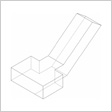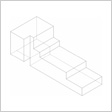Dunne & Raby / Michael Anastassiades
In the field of design, users and consumers are usually characterised in narrow and stereotypical ways resulting in a world of manufactured objects that reflects an impoverished view of what it means to be human. This project set out to explore and develop a design approach that would lead to products that embodied an understanding of the consumer/user as a complex existential being.
To achieve this the project focused on irrational but real anxieties such as the fear of alien abduction or nuclear annihilation. Rather than ignoring them, as most design does, or amplifying them to create paranoia, we treated the phobias as though they were perfectly reasonable and designed objects to humour their owners.
The resulting objects are concrete examples of a very different way of designing for how people really are rather than how they are supposed to be. They explore how psychological realism can be applied to designed objects.
1. Hideaway Furniture is for people who are afraid of being abducted. Each opens in a surprising way without disturbing objects displayed on its surface. The poses encourage the occupant to feel in control, proud and comfortable, the opposite of a foetal position. There are three versions.
2. The Huggable Atomic Mushrooms are for people afraid of nuclear annihilation. Like treatments for phobias they allow for gradual exposure through different sizes.
B&W Photography: Jason Evans
Specialist Carpentry: Ben Legg
Specialist Technical Advice: Nick Williamson
Pattern design/cutting: David England
Seamstress: Anja Huttunen
The Huggable Atomic Mushroom is in the permanent collection of MoMA, New York.
Hideaway Type 2 is in the permanent collection of Frac Ile-de-France, Paris.
In the field of design, users and consumers are usually characterised in narrow and stereotypical ways resulting in a world of manufactured objects that reflects an impoverished view of what it means to be human. This project set out to explore and develop a design approach that would lead to products that embodied an understanding of the consumer/user as a complex existential being.
To achieve this the project focused on irrational but real anxieties such as the fear of alien abduction or nuclear annihilation. Rather than ignoring them, as most design does, or amplifying them to create paranoia, we treated the phobias as though they were perfectly reasonable and designed objects to humour their owners.
The resulting objects are concrete examples of a very different way of designing for how people really are rather than how they are supposed to be. They explore how psychological realism can be applied to designed objects.
1. Hideaway Furniture is for people who are afraid of being abducted. Each opens in a surprising way without disturbing objects displayed on its surface. The poses encourage the occupant to feel in control, proud and comfortable, the opposite of a foetal position. There are three versions.
2. The Huggable Atomic Mushrooms are for people afraid of nuclear annihilation. Like treatments for phobias they allow for gradual exposure through different sizes.
B&W Photography: Jason Evans
Specialist Carpentry: Ben Legg
Specialist Technical Advice: Nick Williamson
Pattern design/cutting: David England
Seamstress: Anja Huttunen
The Huggable Atomic Mushroom is in the permanent collection of MoMA, New York.
Hideaway Type 2 is in the permanent collection of Frac Ile-de-France, Paris.


































